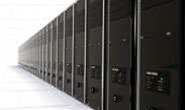EMC unveils storage architecture for virtual data centres
EMC unveils storage architecture for virtual data centres
The company has introduced a new line of high-end Symmetrix storage products based on a building block design that can start small and scale up to support the largest virtual data centre infrastructure.
Available immediately, the Symmetrix V-Max and V-Max SE storage arrays are based on a new Virtual Matrix Architecture that EMC said can scale up to hundreds of thousands of terabytes of storage, and is capable of supporting hundreds of thousands of virtual machines.
EMC marketing vice president Barbara Robidoux said that the new architecture is "the single biggest innovation for the storage industry in years".
The basic building block of the Virtual Matrix Architecture is the V-Max engine, which contains all the necessary disk and I/O ports along with multiple quad-core Intel processors, up to 128GB of memory and EMC's Engenuity storage operating system.
This contrasts with existing storage arrays, which typically require customers to source and manage separate components such as motherboards and host bus adapters, according to Robidoux.
To scale up, customers simply add in another V-Max engine with its associated Flash, Fibre Channel or Sata storage.
Each Symmetrix frame can fit up to eight V-Max engines, for a total 1TB of memory and twice the front-end and back-end connections supported by EMC's current high-end DMX-4 systems, Robidoux said.
An entry-level V-Max SE costs up to 10 per cent less than a DMX-4, but offers significantly more performance thanks to the use of quad-core Intel processors and other changes such as enhancements to Engenuity, she added.
Connectivity options include Fibre Channel, iSCSI, Gigabit Ethernet, or Ficon for IBM mainframe systems.
Tony Lock of analyst firm Freeform Dynamics explained that the modular approach is not entirely new, but that EMC had pushed forward the state-of-the-art.
"What is interesting is that the Virtual Matrix Architecture lets the arrays link together however you want them. It potentially gives storage managers the flexibility they need to make one single giant array, or two or three separate smaller beasts," he said.
To simplify management in virtual environments, the Virtual Matrix Architecture automates storage provisioning, reducing the time and complexity of provisioning storage for virtual machines.
"There's a layer of management that lets customers manage less, not more. You can group together [all] V-Max engines and manage them as one giant resource," said Robidoux.
The management enhancements are probably the most significant feature of the new architecture, according to Lock, because greater automation reduces the possibility of mishaps.
"The most common failure in IT is no longer hardware or software, it's people changing things. The fewer manual steps you have to take to do something, the less chance there is it will go wrong," he said.
EMC is the parent company of VMware, so the new V-Max kit is optimised to work with VMware's virtualisation software. However, Robidoux said that customers will also be able to operate virtual machines based on rival hypervisors such as Microsoft's Hyper-V.
EMC said that the Virtual Matrix Architecture will be enhanced with a Fully Automated Storage Tiering capability by the end of 2009. This will automate the placing of data in a storage hierarchy, according to access patterns and policies set by the administrator.
Such tiered storage could make greater use of Flash solid state drive technology for faster access, combined with a larger pool of the more cost-effective Sata drives, according to EMC.
The entry-level V-Max SE array is based on a single V-Max engine with 48 to 360 disks and costs from US$250,000, while the V-Max has up to eight engines and up to 2,400 disks for a total of two petabytes of storage.







